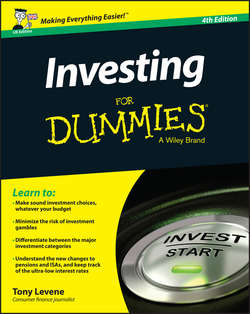Читать книгу Investing for Dummies – UK - Levene Tony - Страница 6
На сайте Литреса книга снята с продажи.
Part I Getting Started with Investing Chapter 3 Recognising What Makes an Investor Tick
ОглавлениеIn This Chapter
▶ Understanding components of investor psychology
▶ Looking at the standoff between greed and fear
▶ Investing as a casino wheel or sensible strategy
▶ Considering money-making routes for the cautious
Needlework and carpentry are among the skills where you need a firm hand and a good eye as well as technical ability. You need technical ability in investing too. But as well as a firm hand and a good eye, you need an understanding of investor psychology – how you tick and how the other investors who make up the market tick as well. This chapter looks at psychology – but don’t worry, you don’t have to read huge tomes or understand long words.
Good investors know all about the mechanics of buying and selling stocks and shares. They know how to tell a positive company balance sheet from a looming disaster. And they understand that a relationship exists between interest rates, inflation and what they end up earning on their investment cash.
Great investors do all that and something more, something far more vital. It doesn’t involve learning how to interpret share earnings forecasts, how to understand credit risks or how to evaluate the future of small companies. What it involves is far more basic – and far more essential.
This extra something is investor psychology, and it’s what this chapter is all about. In this chapter, I tell you what investor psychology actually is and explain some specific emotions that make an investor tick. In addition, I explain that although gambling and investing share certain similar characteristics, they’re actually very different ventures. And for those of you whose emotions range from cautious to scared stiff, I provide some starting-point investing advice.
Understanding Investor Psychology
Investor psychology comes in two parts – the psychology of the marketplace and the psychology of the individual. This section helps you understand each part – and their interaction, because you can’t define where one stops and the other starts.
Конец ознакомительного фрагмента. Купить книгу
